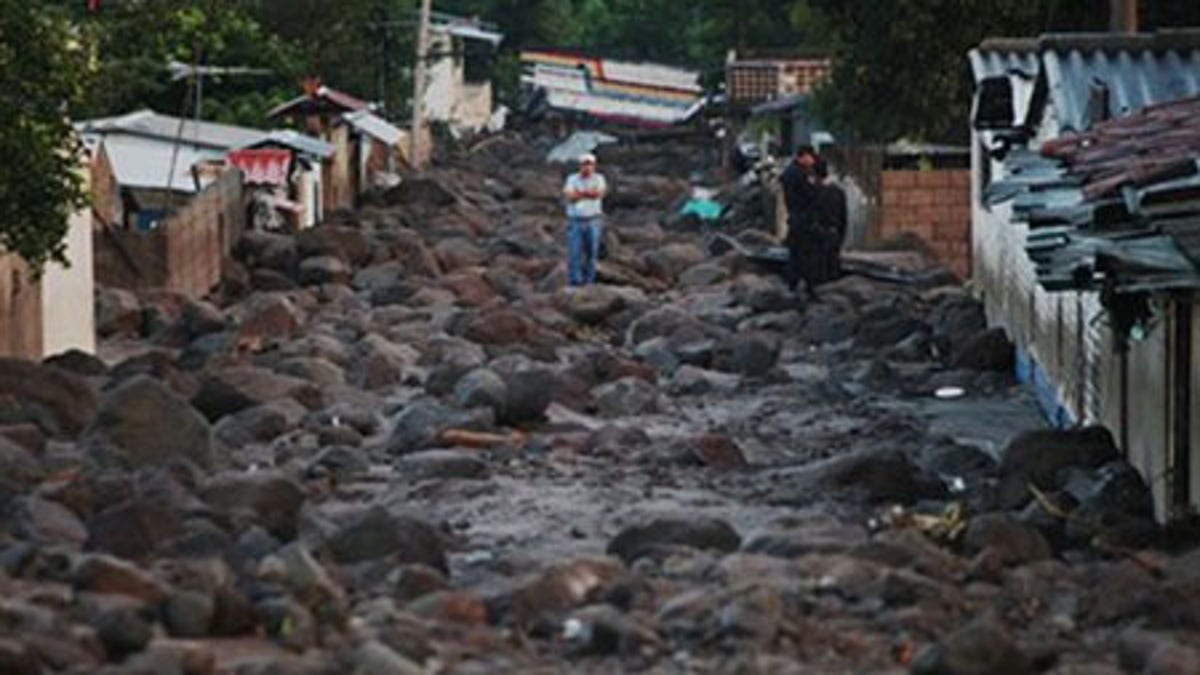
A man stands in a street covered with rocks from a landslide in Verapaz, some 125 km east from San Salvador, Monday, Nov. 9, 2009. (AP Photo)
VERAPAZ, El Salvador – Soldiers and townspeople dug through rock and debris Monday in hopes of finding dozens of people missing in a mudslide that swept down on a town, part of a wave of floods and landslides that killed at least 134 people in El Salvador.
Days of heavy rains loosed mud and boulders that rolled down the slopes of the Chichontepec volcano before dawn Sunday, burying homes and cars in Verapaz, a town of about 7,000 people 30 miles outside the capital, San Salvador.
Hurricane Ida's presence in the western Caribbean late last week may have played a role in drawing the rain-packed, Pacific low-pressure system toward El Salvador on the other side of Central America, said Dave Roberts, a Navy hurricane specialist at the U.S. National Hurricane Center in Miami, Florida.
President Mauricio Funes toured Verapaz on Monday morning, stopping to talk to men shoveling more than three feet of mud from their homes.
"The images speak clearly," Funes told reporters. "This is a disaster."
He urged El Salvador's congress to approve millions of dollars in loans from the Inter-American Development Bank, saying some of the funds would be used for reconstruction.
Soldiers, emergency workers and relatives resumed a search for the missing at daybreak Monday and military helicopters flew in food for the searchers.
Survivor Cruz Ayala described the slide as "something black, like a huge wave, a huge noise, and I heard screams of people asking for help."
She fled and climbed the roof of a neighbor's house without knowing if her 71-year-old mother and two teenage nieces escaped. She later found their bodies in the rubble.
Mayor Jose Antonio Hernandez said rescuers found six more bodies in Verapaz, raising the town's death toll to 16, with 47 confirmed missing.
Nationwide, the death toll stood at 134, Funes told reporters.
With no place to put the bodies in Verapaz, many of the dead were taken to nearby towns until families could claim them.
In the town of San Isidro, eight coffins were lined up in a church that also served as a shelter for about 200 people whose homes were damaged.
Amid a persistent drizzle, rescuers dug frantically for survivors with shovels and even bare hands. But the search was made difficult by collapsed walls, boulders and downed power lines that blocked heavy machinery.
Mario Montoya said his sister, who was eight months pregnant, was among the dead.
"A torrent of water grew and great boulders started to destroy homes. It was terrible," said Montoya, 29.
Matias Mendoza, 26, was at home in Verapaz with his wife, Claudia, and their 1-year-old son, Franklin, when the earth began moving.
"It was about two in the morning when the rain started coming down harder, and the earth started shaking," Mendoza recalled. "I warned my wife and grabbed my son, and all of a sudden we heard a sound. The next thing I knew I was lying among parts of the walls of my house.
"A few minutes later, I found my wife and my son in the middle of the rubble, and, thank God, we're alive," said Mendoza, who suffered cuts on his cheek that emergency workers stitched up.
Almost 7,000 people saw their homes damaged by landslides or cut off by floodwaters following three days of downpours from the low-pressure system.
San Vicente Gov. Manuel Castellanos said workers were struggling to clear roadways, and power and water service had been knocked out. At least 300 houses were flooded when a river in Verapaz overflowed its banks, Lopez Mendoza said.
